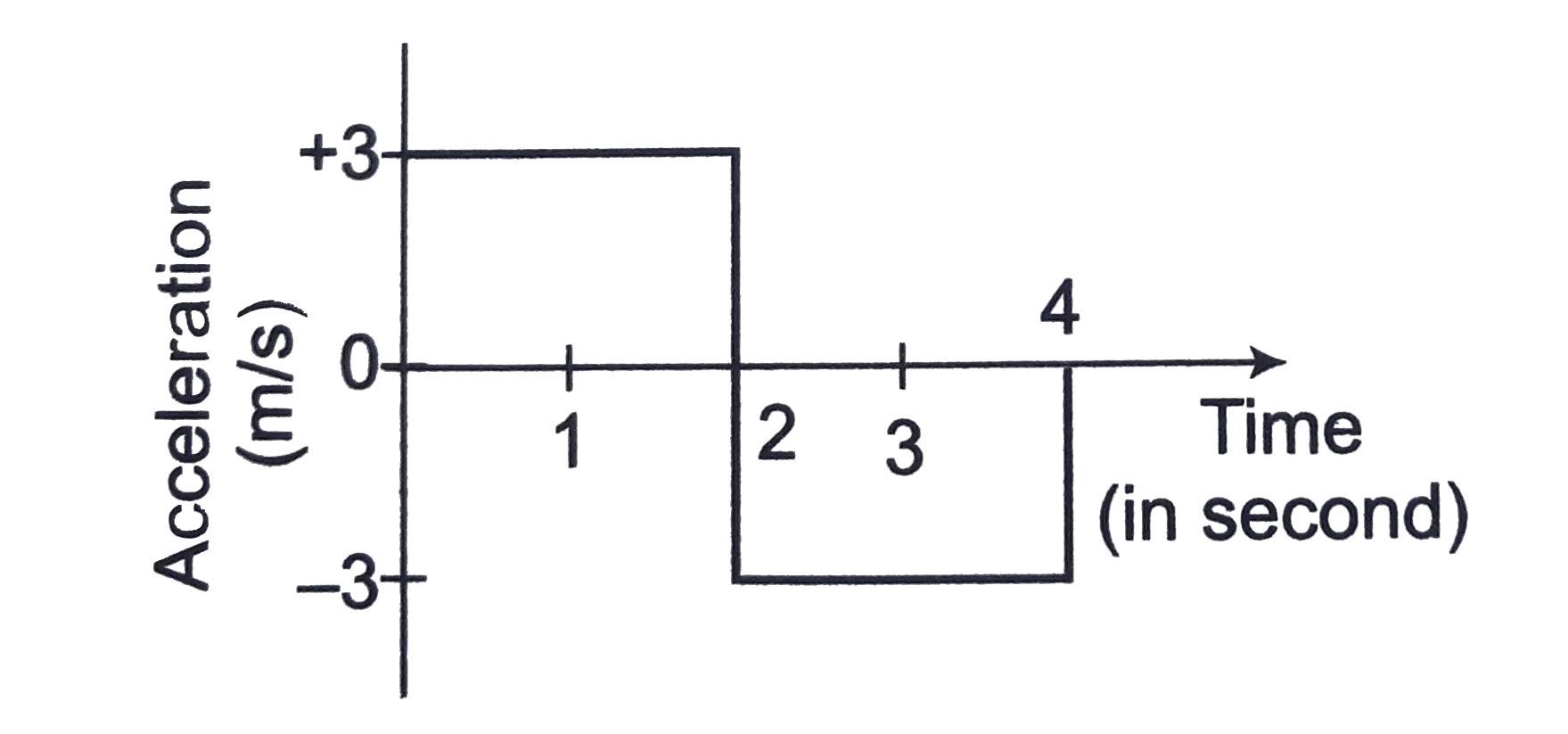A particle moves in a straight line with constant acceleration a. The displacements of particle from origin in times t1,t2andt3ares1,s2ands3 respectively. If times are in AP with common difference d and displacements are in GP, then prove that a=(√s1−√s3)2d2
The correct Answer is:A
To solve the problem, we will follow these steps:
Step 1: Understand the given conditions
We have a particle moving in a straight line with constant acceleration a. The displacements at times t1,t2, and t3 are s1,s2, and s3 respectively. The times t1,t2,t3 are in Arithmetic Progression (AP) with a common difference d, and the displacements s1,s2,s3 are in Geometric Progression (GP).
Step 2: Express the times in terms of t2
Since t1,t2,t3 are in AP with a common difference d:
- t1=t2−d
- t2=t2
- t3=t2+d
Step 3: Use the equations of motion
The displacement of a particle under constant acceleration is given by the equation:
s=ut+12at2
Assuming the initial velocity u=0 (the particle starts from rest), the displacements can be expressed as:
- s1=12at21
- s2=12at22
- s3=12at23
Step 4: Substitute the values of t1,t2,t3
Substituting the expressions for t1,t2,t3:
- s1=12a(t2−d)2=12a(t22−2dt2+d2)
- s2=12at22
- s3=12a(t2+d)2=12a(t22+2dt2+d2)
Step 5: Use the GP condition
Since s1,s2,s3 are in GP, we can use the property of GP:
s22=s1⋅s3
Substituting the expressions for s1,s2,s3:
(12at22)2=(12a(t2−d)2)(12a(t2+d)2)
Step 6: Simplify the equation
Cancelling 14a2 from both sides:
t42=(t22−2dt2+d2)(t22+2dt2+d2)
Expanding the right-hand side:
t42=t42+2d2t22−4d2t2+d4
This simplifies to:
0=2d2t22−4d2t2+d4
Step 7: Factor the equation
Factoring out d2:
0=d2(2t22−4t2+d2)
This gives us:
2t22−4t2+d2=0
Step 8: Solve for t2
Using the quadratic formula:
t2=4±√16−8d24=1±√2(2−d2)2
Step 9: Relate to acceleration a
From the previous steps, we can relate a to the displacement:
a=(s1−s3)d2
Substituting the values:
a=(√s1−√s3)2d2
Conclusion
Thus, we have proved that:
a=(√s1−√s3)2d2
We have a particle moving in a straight line with constant acceleration a. The displacements at times t1,t2, and t3 are s1,s2, and s3 respectively. The times t1,t2,t3 are in Arithmetic Progression (AP) with a common difference d, and the displacements s1,s2,s3 are in Geometric Progression (GP).
Since t1,t2,t3 are in AP with a common difference d:
- t1=t2−d
- t2=t2
- t3=t2+d
The displacement of a particle under constant acceleration is given by the equation:
s=ut+12at2
Assuming the initial velocity u=0 (the particle starts from rest), the displacements can be expressed as:
- s1=12at21
- s2=12at22
- s3=12at23
Substituting the expressions for t1,t2,t3:
- s1=12a(t2−d)2=12a(t22−2dt2+d2)
- s2=12at22
- s3=12a(t2+d)2=12a(t22+2dt2+d2)
Since s1,s2,s3 are in GP, we can use the property of GP:
s22=s1⋅s3
Substituting the expressions for s1,s2,s3:
(12at22)2=(12a(t2−d)2)(12a(t2+d)2)
Cancelling 14a2 from both sides:
t42=(t22−2dt2+d2)(t22+2dt2+d2)
Expanding the right-hand side:
t42=t42+2d2t22−4d2t2+d4
This simplifies to:
0=2d2t22−4d2t2+d4
Factoring out d2:
0=d2(2t22−4t2+d2)
This gives us:
2t22−4t2+d2=0
Using the quadratic formula:
t2=4±√16−8d24=1±√2(2−d2)2
From the previous steps, we can relate a to the displacement:
a=(s1−s3)d2
Substituting the values:
a=(√s1−√s3)2d2
Thus, we have proved that:
a=(√s1−√s3)2d2
Topper's Solved these Questions
- BOOK - DC PANDEY ENGLISHCHAPTER - KINEMATICSEXERCISE - SCQ_TYPE39videos
KINEMATICS
- BOOK - DC PANDEY ENGLISHCHAPTER - KINEMATICSEXERCISE - MCQ_TYPE23videos
KINEMATICS
- BOOK - DC PANDEY ENGLISHCHAPTER - KINEMATICSEXERCISE - Comprehension7videos
KINEMATICS
- BOOK - DC PANDEY ENGLISHCHAPTER - GRAVITATIONEXERCISE - (C) Chapter Exercises45videos
GRAVITATION
- BOOK - DC PANDEY ENGLISHCHAPTER - KINEMATICS 1EXERCISE - INTEGER_TYPE15videos
KINEMATICS 1
Similar Questions
A particle starts from rest at t=0 and moves in a straight line with an acceleration as shown below. The velocity of the particle at t=3 s is
 View Solution
View SolutionA particle, initially at rest, starts moving in a straight line with an acceleration a=6t+4m/s2. The distance covered by it in 3 s is
View SolutionA particle starts motion from rest and moves along a straight line. Its acceleration-time graph is shown. Find out speed of particle at t=2s and at t=3s.
 View Solution
View SolutionA particle moves along a staight line such that its displacement at any time t is given by s=t3−6t2+3t+4m. Find the velocity when the acceleration is 0.
View SolutionA particle moves along a straight line such that its displacement at any time t is given by s=3t3+7t2+14t+5. The acceleration of the particle at t=1s is
View SolutionVelocity of a particle moving in a straight line varies with its displacement as v=(√4+4s)m/s. Displacement of particle at time t=0 is s=0. Find displacement of particle at time t=2s.
View SolutionA particle moves along the x-direction with constant acceleration. The displacement, measured from a convenient position, is 2 m at time t=0 and is zero when t=10s. If the velocity of the particle is momentary zero when t=6s, determine the acceleration a and the velocity v when t=10s.
View SolutionA particle having initial velocity u moves with a constant acceleration a for a time t. a. Find the displacement of the particle in the last 1 second . b. Evaluate it for u=5m/s,a=2m/s2andt=10s.
View SolutionA particle moves in a straight line such that its position in 't' time is s(t)=t2+3t−1 cm. find its velocity at t=4 sec.
View SolutionFor a particle moving in a straight line, the displacement of the particle at time t is given by
S=t3−6t2+3t+7
What is the velocity of the particle when its acceleration is zero?View Solution

